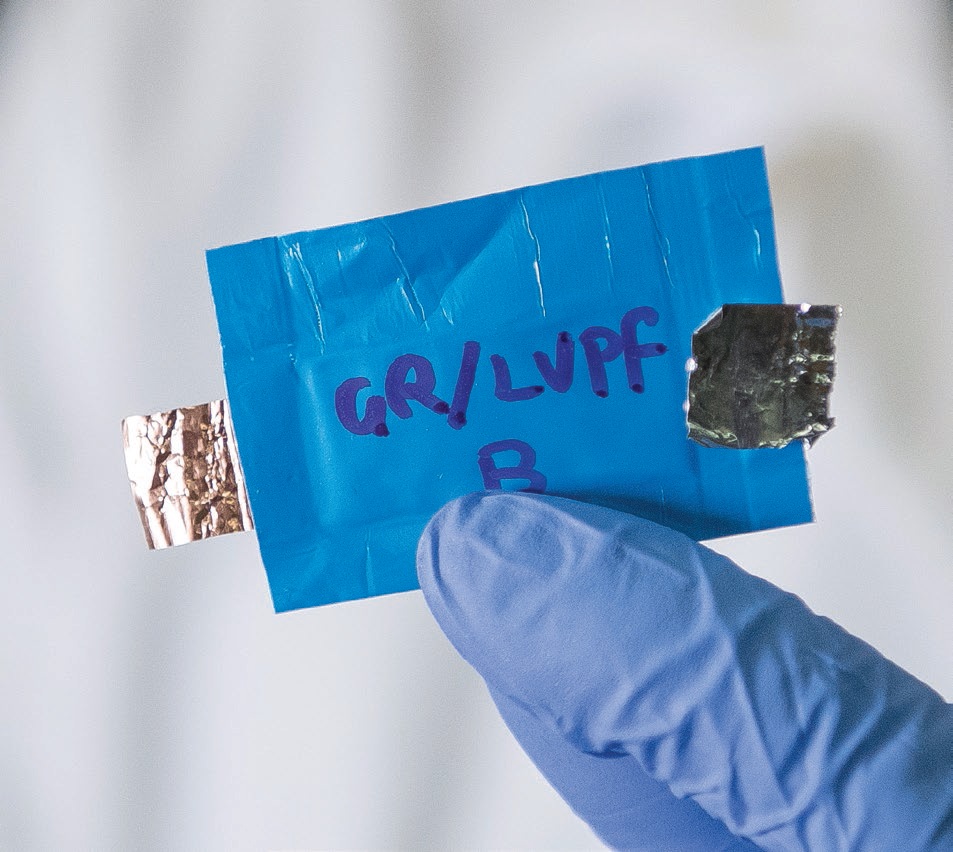Safer lithium-ion batteries
Dr. Neil Canter, Contributing Editor | TLT Tech Beat January 2018
A water-based electrolyte can now be used in a battery that meets the desired voltage requirements.
KEY CONCEPTS
•
Development of a water-based lithium-ion battery with improved thermal stability may be closer due to the development of a hydrophobic gel that coats the graphite anode.
•
The hydrophobic gel expels water from within one nanometer of the graphite electrode interface minimizing hydrogen gas evolution.
•
When combined with a high-voltage cathode, the graphite electrode with the thin gel layer produces a voltage in excess of 4.2 volts, which is a requirement for lithium-ion batteries.
INTEREST IN IMPROVING THE PERFORMANCE OF BATTERIES used in electric cars is growing rapidly. The key driver is that markets such as China have decided to ban the sale of internal combustion engine-powered vehicles in the future. Electric cars have emerged as one of the alternatives, and some countries have mandated sales targets for this automobile type.
The preferred power source for use in electric cars continues to be lithium-ion batteries. Operational problems have emerged in using them, some of which have been discussed in this column. In a previous TLT article, the battery anode, which is typically based on graphite, was found to be a problem due to limitations on power output (
1). The researchers claimed that graphite’s layered structure facilitated the plating out of lithium leading to battery failure, some of which was catastrophic due to fire and explosion.
Dr. Kang Xu, ARL Fellow and team leader at the U.S. Army Research Laboratory in Adelphi, Maryland, comments on current problems with using lithium-ion batteries. He says, “Over the past 20 years, the use of lithium-ion batteries has gradually been scaled up from applications in small devices such as cell phones to large machines such as automobiles. Problems with lithium-ion batteries include the high cost to process and the need to hermetically seal them, which adds manufacturing constraints and rigid form-factors.”
But the biggest concern is still safety due to the flammability and toxicity of the organic liquid electrolyte. Xu says, “These negative characteristics led to the conclusion that the most ideal electrolyte would be based on water which is green, safe and not flammable.”
But water presents its own set of challenges because it can only operate over a narrow electrochemical stability range. Xu says, “Water can only be used up to a maximum of 1.23 volts, which means that it is sufficient only for a one-volt battery. This is not suitable for lithium-ion batteries that have voltage requirements in the 4-4.5-volt range.”
For the past three years, Xu and his collaborator, professor Chunsheng Wang from the University of Maryland, have worked on approaches to stabilize water electrochemically. The researchers transplanted a concept known as solid-electrolyte-interphase (SEI) from a non-aqueous to an aqueous environment by developing “water in salt” electrolytes (WISE).
Professor Wang says, “We were able to increase the voltage of water-based lithium-ion batteries to three volts. But we found that trying to attain four volts proved to be extremely difficult.”
The challenge for the researchers was overcoming the evolution of hydrogen gas through the decomposition of water at the anode. This was termed by these researchers as the “cathodic challenge.”
Dr. Chongyin Yang, who is the assistant research scientist at the University of Maryland and the first author of the work, says, “At the anode, the operating conditions lead to anions being expelled from the electrode surface and the adsorption of water. The result favors hydrogen evolution preventing the formation of a SEI. A cation deficit is now present that cannot be resolved through simply adding a higher concentration of salts.”
A new approach is needed to increase the lithium-ion battery voltage up to the desired range. Such an approach has now been developed.
PHYSICAL MEANS
The researchers overcame the cathodic challenge through physical means by developing a strongly hydrophobic gel that physically expels water from within one nanometer for the graphite electrode interface. This gel was prepared by mixing lithium bis(trifluoromethane)sulfonyl imide with a highly fluorinated ether, 1,1,2,2,-tetrafluoro-2’,2’,2’-trifluoroethylether in the presence of 10% by weight polyethylene oxide at 70 C.
Dr. Yang says, “The mixing process between the lithium salt and the highly fluorinated ether produced a translucent gel that has a maximum thickness of 10 microns. The water level near the electrode drops to approximately 30 ppm ensuring that hydrogen formation will not occur.”
Xu and Wang credited Dr. Yang for identifying the fluorinated ether by screening a large number of chemicals. Xu says, “The fluorinated ether used by Dr. Yang was low cost because it is a byproduct from a commercial process.”
In testing, the graphite electrode with the thin gel layer displayed lithium-ion intercalation behavior down to 0.1 volt, which is exactly what graphite is required to do in a lithium-ion battery. When coupled with a high-voltage cathode, an aqueous lithium-ion cell of greater than 4.2 volts can be fabricated. Cyclic voltammetry testing showed that the SEI formation took place during the first cycle. This is reflected in the lower Coulombic efficiency of 85%. But this efficiency increases to over 99% in the next cycle.
An image of the graphite electrode coated with the thin gel layer is shown in Figure 2.
 Figure 2. Application of a hydrophobic coating on a graphite anode enabled a water-based lithium-ion battery to be developed with sufficient voltage for commercial use. (Figure courtesy of U.S. Army Research Laboratory.)
Figure 2. Application of a hydrophobic coating on a graphite anode enabled a water-based lithium-ion battery to be developed with sufficient voltage for commercial use. (Figure courtesy of U.S. Army Research Laboratory.)
Xu says, “We evaluated the safety of the graphite electrode with the thin gel layer by running differential scanning calorimetry to assess its thermal stability. The rupture temperature was found to be approximately 220 C. This is much higher than the rupture temperature obtained for the anode previously developed that reached a maximum voltage of 3 volts. That electrode has a rupture temperature between 160-180 C.”
“We also assembled full lithium-ion cells for safety abuse tests, in which nails were driven through the cell but did not cause any catastrophic failures,” says Wang.
This work is significant because it determines from a proof of concept that a safer, water-based lithium battery can be prepared with good thermal stability. Xu says, “So far the cycle life of the battery only went past 100 cycles, so our future work will be to improve performance and durability. Our goal is to have the battery exceed 1,000 cycles.”
Additional information on this research can be found in a recent article (
2) or by contacting T’Jae Gibson Ellis in the Office of Public & Congressional Affairs at the U.S. Army Research Laboratory at
tanya.j.gibson.civ@mail.mil.
REFERENCES
1.
Canter, N. (2017), “Lithium-ion battery anode from fungus,” TLT,
72 (7), pp. 12-13.
2.
Yang, C., Chen, J., Qing, T., Fan, X., Sun, W., Cresce, A., Ding, M., Borodin, O., Vatamanu, J., Schroeder, M., Eidson, N., Wang, C. and Xu, K. (2017), “4.0 V Aqueous Li-Ion Batteries,”
Joule,
1 (1), pp. 122-132.
 Neil Canter heads his own consulting company, Chemical Solutions, in Willow Grove, Pa. Ideas for Tech Beat can be submitted to him at neilcanter@comcast.net
Neil Canter heads his own consulting company, Chemical Solutions, in Willow Grove, Pa. Ideas for Tech Beat can be submitted to him at neilcanter@comcast.net.